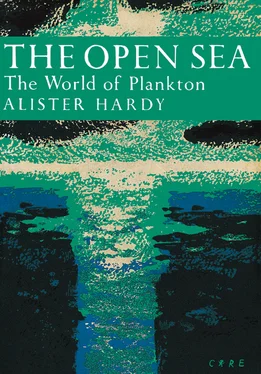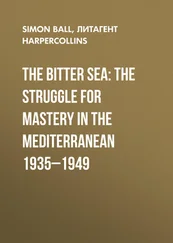Smaller still, of course, are the bacteria which really lie outside the scope of this book; at present, very little is known about their occurrence in the plankton. Dr. H. W. Harvey (1945) states that their population density decreases on passing from inshore waters to the open sea and that in the ocean the greatest numbers are found where phytoplankton is abundant and in the water immediately above the sea-floor. They are found particularly in dense phytoplankton regions because of the undigested organic matter passed out by the animals which are eating more of the plants than they really require.
It is exceedingly difficult to get an accurate measure of the amount of plant life in a given quantity of sea water, even of the larger forms which are captured by a net. Although we can calculate the filtering efficiency of the net and know the quantity of water it should filter, we cannot be sure that it actually does filter this amount; in fact it rarely does, for to a varying extent under different conditions the meshes of the net become clogged by the organisms themselves and the filtering is much reduced. However we can get an approximate idea of the number of larger forms—the diatoms and dinoflagellates—in a given volume of water by using a net. Let us take an example. In 1907 Sir William Herdman and his co-workers began an intensive study of the plankton of Port Erin Bay in the Isle of Man which they continued until the end of 1920. Usually six times a week, every week for fourteen years, two standard nets of coarse and fine mesh were towed in exactly the same way over the same distance—half a mile—across the bay. Johnstone, Scott and Chadwick, who describe the results in their book The Marine Plankton (1924), estimate that for each such double haul “taking the two nets we shall not be very much in error (when all the conditions are considered), in assuming that 8 cubic metres of water were filtered through both nets.” The following figures, taken from their book, give the average number of the principal plant forms taken in such a catch during the month of April, i.e. the average of all the April hauls made over fourteen years:

That in round figures is 727,000 per cubic metre or about 20,000 per cubic foot. The number of plankton animals taken at the same time is given in Chapter 5where the zooplankton is considered and may be compared here. The actual numbers present are estimated by using a specially calibrated pipette which takes up a known fraction of the sample; the fraction is spread out on a glass slide ruled in squares so that the number of plant cells can be counted below the microscope just as the corpuscles are counted in a sample of blood. We must remember two important things about the figures just given. Firstly they are for the larger microscopic plants; the very small ones are present in far greater numbers as we shall see in a moment. Secondly they are average figures for April over fourteen years; those for one year may be very different from those of another and the average figures for other months of the year will show still greater differences. There are marked seasonal changes in the plankton; but that is the subject of our next chapter.
The difficulty of knowing exactly how much water is filtered by a net when its meshes are becoming clogged by the organisms sampled, has been got over by an ingenious device invented by Dr. Harvey of Plymouth (1934). At the mouth of the tow-net he has fixed a little propeller which is turned by the water flowing into it; the number of revolutions it makes are recorded on little dials which measure the amount of water actually passed through the net. There is still, however, the difficulty of forming a true quantitative estimate of the plant life present. We can calculate, as we have just seen, the number of plant-cells in the sample; but these vary so enormously in size it is difficult to convert such an estimate into a measure of the total bulk of planktonic vegetation. Measurements of the volume of the sample can be made after all the plants have been killed by the addition of formalin and allowed to settle for several days in the bottom of a measuring jar; but this too is a very misleading estimate, because the various kinds, having different shapes, may pack together very differently: for example spiny forms take up more space than round or flat ones. However, these various methods do enable us to say broadly that one area is relatively so much richer in phytoplankton than another—always excluding the small flagellates which escape the net and must be estimated with the centrifuge. A more recent method of estimating the quantity of plant life caught in a plankton sample is to extract the plant pigment by acetone and measure the quantity present by matching up the samples obtained with a standard colour scale and expressing it in so many pigment units.
The late Dr. E. J. Allen (1919), when Director of the Plymouth Laboratory, made a simple but important experiment that gives us some idea of the vast numbers of little plants there are in the sea which are not caught by our ordinary methods. He had first perfected a method of growing them in bottles in a special culture solution, i.e. in sea water enriched with the addition of certain beneficial chemicals. He then took a sterilised quart-sized bottle and filled it with sea water from just below the surface about half a mile outside the Plymouth breakwater. This water he treated in two ways. The procedure may seem a little involved but it is worth following. Firstly he took four 10 cc samples of it and centrifuged them each twice with the result that he obtained an average of 14.45 organisms per 1 cc of water which gives us an estimate of 14,450 per litre. Secondly he took just ½ cc of the water he had collected and added it to 1,500 cc of his culture solution which he had previously sterilized; then after it had been thoroughly shaken up he divided this between 70 small flasks—a little over 20 cc in each—and placed them against a north window. After 10 days signs of growth were apparent. When they were finally examined there was not a flask that had not had some growth in it. He now recorded the different kinds of organisms in each. In two flasks there was only one species; in all the others there were from two to seven different species present, giving an average of 3.3 different kinds per flask. Thus at least 70 × 3.3 or 231 separate plants must have been taken up in the ½ cc originally added to the culture solution; that makes 464,000 per litre as compared with the 14,450 estimated by using the centrifuge! For comparison with the larger plant forms caught by the net in the former example we must express the number as per cubic metre: i.e. 464 million, or about 12½ million per cubic foot. Now this must be regarded as an absolute minimal estimate, for it is made by assuming that only one individual of each kind of plant recorded in a flask went into that flask at the beginning; this is most unlikely.
We begin to have some idea of the great wealth of plant life there is in the sea. Can we make it still richer by adding fertilizers in the same way as we increase our crops on land? Experiments have been made in that direction, but a discussion of them will come better in the next chapter, where we will deal with the various factors which govern phytoplankton production. For a more detailed and fuller account of the pelagic plants in general I would recommend for further reading the splendid chapter by Professor H. H. Gran in Murray and Hjort’s Depths of the Ocean (1912).
1 They were subsequently well described by G. Murray and V. H. Blackman 1898).
Читать дальше













